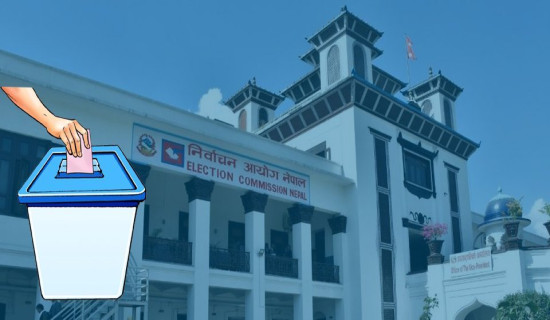- Saturday, 20 December 2025
Public Transport Awaits Drastic Reforms
Numerous countries from around the world have made substantial reforms in their public transport systems over the past decades. Their transport systems appear to have been more passenger-friendly when it comes to comfort, efficiency and cost. They have made such strides by implementing proper plans, policies and laws and using new transport technology. Nepal has also come a long way in terms of the expansion of the road network in recent years. The country has encouraged private investments in public transport.
But this important sector is still in a mess. Passengers are forced to face a lot of inconvenience because of the poor transport system. Despite the abolition of the notorious transport syndicate seven years ago, passengers are failing to experience any desirable change in terms of service quality. The public transport is a service sector in nature. But the existing laws seem to treat it as a business.
Selfish demands
There has been a bad practice among transport operators to resort to a strike when government authorities take any measure aiming at revamping this sector. When strikes are used as a tool to get their selfish demands met, overhauling the public transport system has now become increasingly challenging. Passenger bus operators and taxi or truck owners still seem to be so organised and powerful that they opt for a strike even when the traffic police intensify road checking. The nation witnesses such cases frequently. This tendency is one of the major impediments on the way to public transport reforms.
Just one week ago, at the call of the Federation of Nepali National Transport Entrepreneurs (FNNTE), transport operators were on a nationwide strike, seeking revocation of the new Ride-Sharing (Regulation and Management) Guidelines, 2025, introduced by the Gandaki provincial government. With this legal framework, the provincial government aimed to regulate the ride-sharing business that has been gaining ground gradually. The strike disrupted life across the country for two consecutive days (Monday and Tuesday) as all public vehicles were off the road. Transport entrepreneurs and workers also resorted to vandalising other vehicles plying the roads in various parts of the country. The agitating transport entrepreneurs intended to revive the syndicate by piling unnecessary pressure on the government. Being profit mongers, they wanted to stop new transport companies from receiving route permits to promote their monopoly.
Given the adverse impact of the indefinite transport strike on the lives of people and the national economy as a whole, the federal government held several rounds of talks with the representatives of the transport operators before inking a six-point deal with them. One of the points of the deal was that the federal government had to request the Gandaki provincial government to put the enforcement of the regulation on hold for a month. The strike was called off only after the provincial government decided to follow the federal government’s call in this regard. Different sections of society, including lawmakers and civil society members, have flayed the federal government for giving in to the transport operators. The Gandaki provincial government was in favour of enforcing the guidelines by regulating and facilitating ride-sharing businesses to ensure better services to passengers, creating more jobs within the province and increasing revenue.
Notably, the federal government had taken a bold step to end the decades-long transport syndicate. In May 2018, the government and transport operators had reached a deal on this issue. The transport operators had vowed to abide by the government’s policy to register their companies as per the Companies Act. But, it appears that the transport entrepreneurs have forgotten that agreement and tried to defy it. Before the elimination of the transport syndicates, the nation’s entire public transport system had been under the control of a few private operators. New transport firms had to struggle hard to receive route permits from strong syndicates.
The successive governments seem to have come up with plans to improve the public transport system. The 15th five-year plan document had envisioned developing metros, light rails and trolleys. In their annual budgets, the succeeding governments have promised to revamp the transport system. Meanwhile, the federal government aims to attract more private investments for operating smart public transport in the upcoming fiscal year 2025-26. Two years ago, it was announced to make the public transport system easily accessible, safe, reliable and environment-friendly. But no tangible effort has been made to materialise those pledges. Even in urban centres like the Kathmandu Valley, the public transport system is not passenger-friendly. Small and rickety buses are in operation on most routes. They remain highly congested in peak hours. Even if a passenger finds a seat, it is mostly dirty and uncomfortable. Passengers often face perennial hassles from helpers and drivers. They are also often overcharged on one pretext or the other.
New law in pipeline
A new federal transport law is in the pipeline to regulate this sector. The law must incorporate the provisions that can help deal with the persisting anomalies seen in public transport effectively. The legal provisions should be in line with the vision of the 16th Five-Year Plan to make drastic reforms in the public transport system. The law must also be in support of competition and openness instead of a monopoly. This alone can enhance the quality of services. This sector must be brought under the Essential Services Act to prevent strikes. There is no doubt that the government has the responsibility of safeguarding the investment of transport entrepreneurs. But, this must not be done at the cost of people’s welfare and new investors.
The 16th plan that has commenced since the current fiscal year envisages devising appropriate policies and laws for the development of a multimodal transport system. It seeks to ensure a citizen-friendly, sustainable, safe, cost-effective, dignified, inclusive and reliable transport system. The state should also review its transport policy and invest in public transport to smoothly manage this sector. The existing law enforcement and monitoring mechanisms should also be strengthened.
(The author is a former deputy executive editor of this daily.)

















